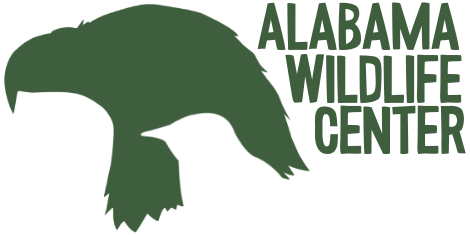Effective November 16th, 2022:
Until further notice, due to avian influenza, the Alabama Department of Conservation & Natural Resources has suspended the intake and rehabilitation of all species of waterfowl, shorebirds, wading birds, pelican, gull, corvid, and all raptor species, to include eagles, hawks, falcons, kites, harriers, osprey, vultures, and owls. From the Alabama Department of Conversation and Natural Resources: Members of the public seeking assistance with these species should be instructed not to touch the bird, to leave it where found, and to contact the Alabama Division of Wildlife and Freshwater Fisheries at 334-242-3469 with any concerns about HPAI.
WE ARE STILL PERMITTED TO ACCEPT ALL NATIVE SONGBIRDS.
If you have found an injured Eagle, Hawk, Owl, Vulture, or other raptor, AWC will try to help you get the bird to our rehabilitation clinic at Oak Mountain State Park in Pelham (just south of Birmingham).
If you are closer to Opelika, we will try to help you get the bird to the Southeastern Raptor Center at the Auburn School of Veterinary Medicine.
Never put a wild bird in a wire cage, because it will cause extra stress and may cause additional damage to the bird.
How to Capture & Confine an Injured Raptor
- ALWAYS wear thick leather (welding) gloves or other protective clothing when attempting to handle a raptor.
- Most birds of prey use their feet as their primary defensive weapon. The talons are long and sharp, and can penetrate through skin and muscle all the way to the bone.
- A raptor’s beak may also be a dangerous weapon. Some birds, such as Great Horned Owls, Vultures, or Ospreys, are especially prone to turning around and biting at someone who is holding them. It’s a good idea to wear some extra padding, such as a heavy jacket, if you are going to have to pick up one of these birds.
- Covering the eyes helps to calm a bird, and also prevents him from seeing what you are doing. Hold a large towel or blanket in front of you like a blind, and slowly approach the bird. Drop the towel over the bird, and (wearing welding gloves) pick it up through the covering, with the feet pointing away from you.
- Grasp the bird from behind, gently but firmly clasping the wings against the body, with the legs extended forward away from you. Immediately place it in a sturdy box of an appropriate size. Remember that any handling is seen as a threat, and causes severe stress to an already weakened animal.
- Cardboard boxes make the best containers because the bird has the sense of being hidden inside the box and is not as aware of its surroundings. The darkness by itself has a soothing effect on most birds.
- Be sure to use some kind of bedding to support the bird in the box. Shredded newspaper, clean pine straw, an old t-shirt or other clothing can be used. A towel over the box will act as an additional buffer to stressful light and noise.
- Box size must be appropriate to the size of the bird, especially when transporting long distances. Use the dimensions below as a guide:
(Screech Owls, Kestrels, Merlins, Sharp-shinned Hawks)
(Red-shouldered, Red-tailed, Broad-winged and Cooper’s Hawks; Barn, Barred, and Great-horned Owls)
- Do NOT give it any food or water (unless advised by AWC specialist to do otherwise).
If you can make the transport to our rehab clinic yourself, please know we’re open every day of the year from 11:00AM to 4:00PM for bird admissions.
